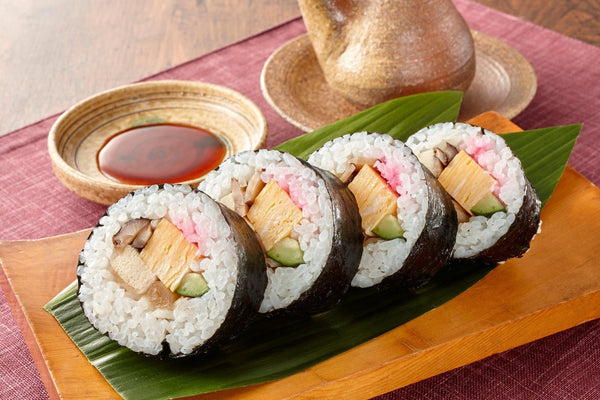
Jump to:
Kimbap and sushi are both delicious treats that appear quite similar. While most people know that sushi comes from Japan and kimbap comes from Korea, are they similar? Are they different? In this edition of the Japanese Taste blog, let’s explore sushi and kimbap in-depth, delve into their histories and uncover their similarities and differences.
What Is Sushi?

Sushi is a traditional Japanese dish that consists of vinegared rice combined with various ingredients, such as raw seafood and vegetables. Sushi is typically served with condiments like soy sauce, wasabi, and pickled ginger. Sushi comes in various forms and styles, each with its own unique preparation and presentation, but in this article, we will focus particularly on makizushi or sushi rolls.
Is Sushi Japanese?
Yes, sushi is Japanese. This is definitely not a difficult question to answer! Sushi is a significant part of Japanese cuisine and culture, known for its emphasis on fresh ingredients, delicate flavors, and aesthetic presentation.
Common Sushi Ingredients
Depending on the style of sushi you’re making, you’ll most likely need some type of nori seaweed sheet. You’ll also need a good soy sauce and wasabi for dipping the sushi in, and maybe even (highly recommended) some pickled ginger.
But don’t forget about the toppings! Of course, you can use whatever you have or what is available to you, but here are some of our recommendations.
- Fish – Tuna, salmon, and yellowtail are popular choices! If you can’t find fresh seafood in your area, you can always go for canned tuna.
- Seafood – Cooked octopus and squid sashimi are also popular choices for sushi. Though some may find these options a bit outside of their comfort zones, they are popular sushi toppings in Japan. Eel (unagi) also tastes delicious if you can get your hands on it.
- Tamagoyaki – This sweet and savory egg dish is a must for us when it comes to sushi! You can also go for these premade shredded egg strips if you’re in a hurry.
- Vegetables – Avocado, cucumber, daikon radish sprouts, shiso, and pickled vegetables (tsukemono) are all great options. You really can’t go wrong with any of your favorite veggies though.
- Sauces – While soy sauce is usually the only sauce used for dipping sushi, you can of course use other sauces if you’d like. Want to add a citrusy kick to your sushi? Go for a ponzu sauce! Another unique dipping sauce idea would be this smoked soy sauce. Kewpie mayo is a popular condiment for sushi rolls, especially when paired with sriracha to make spicy mayo.
How To Make Sushi?

Making sushi at home requires a little bit of prep work, but it’s a fun experience that you should try at least once! In order to effectively make sushi, make sure that you have all of your ingredients prepared and laid out. You’ll need prepared sushi rice, some of the above ingredients we mentioned (your choice!) and of course, nori sheets.
- Lay a nori sheet on the bamboo mat covered with plastic wrap.
- Spread a handful of rice over the nori, leaving an inch at the top.
- Place fillings in a line across the center of the rice.
- Roll the bamboo mat away from you, keeping it tight. Wet the edge of the nori to seal the roll.
- Slice the roll into pieces with a wet knife.
- Serve with soy sauce, wasabi, and pickled ginger. Enjoy!
For more tips, tricks, and recipes, be sure to check out this article.
History Of Sushi
In ancient Japan, fish was preserved by fermenting it in rice, a process that took years. There were two traditional styles: kirimi sushi, where fish was mixed with rice and fermented, and sugata sushi, where whole fish was fermented in rice.
During the mid-Edo period, vinegared rice (sumeshi) was introduced, leading to the evolution of haya sushi, or "fast sushi." This new method significantly reduced fermentation time, allowing rice to be eaten along with the fish. Haya sushi branched into varieties like Hako Sushi (boxed sushi) and chirashi sushi (scattered sushi), while sugata sushi evolved into maki sushi (rolled sushi) and Inari sushi.
The creation of maki sushi is attributed to a customer's request during the mid-Edo period. He suggested a novel presentation for mackerel sushi, leading the chef to slice the fish thinly, wrap it around rice, and cut it into rings. To solve the issue of sticky rice on the outside, the chef wrapped the roll in edible seaweed, thus inventing maki sushi. This style spread throughout Japan, with variations in wrapping materials depending on the region.
What Is Kimbap?

Kimbap, also called gimbap, is a seaweed rice roll made of gim (a sheet of dried seaweed) and bap (rice). It’s filled with various vegetables, proteins such as marinated beef or tuna, and pickled vegetables like takuan (pickled radish) or kimchi. The roll is then wrapped up and cut into bite-sized pieces.
Kimbap is a popular food often associated with picnics, potlucks, and other communal events. It’s also commonly enjoyed at home and as a street food in Korea.
Common Kimbap Ingredients
As mentioned, the most important ingredients for kimbap are dried seaweed sheets and rice. Beyond that, the world of kimbap is your oyster! If you’re new to kimbap and don’t know where to start, here are some suggestions.
- Vegetables – Carrots, spinach, cucumbers
- Protein – Marinated beef, canned tuna, imitation crab, sausage
- Other – Pickled radish (takuan or danmuji), kimchi, omelette strips, cheese
History Of Kimbap
There are a few theories of how kimbap originally came to be, but the most commonly accepted one is that kimbap was influenced by sushi (particularly makizushi) during the Japanese occupation of Korea (1910-1945).
However, while the style of making kimbap (rolling cooked rice in nori seaweed sheets) is inspired by sushi rolls, the fillings consist of traditional Korean ingredients.
Similarities Between Sushi And Kimbap

Of course the biggest similarity between (maki)sushi and kimbap is the fact that they are both made by rolling rice and other filling ingredients with nori sheets. They also both use short grain rice, and are both rolled using a bamboo rolling mat. Of course, kimbap and sushi are both super versatile as well!
Is Kimbap Considered Sushi?
Despite the similarities between kimbap and sushi, they are not considered to be the same thing. Kimbap is Korean, while sushi is Japanese. Beyond their different origins and cultural contexts, they also use different ingredients (beyond the nori seaweed and rice) and are prepared slightly differently. For example, the rice for sushi is seasoned with rice vinegar, sugar, and salt, whereas the rice for kimbap is seasoned with sesame oil and salt. Additionally, kimbap is often brushed with sesame oil once prepared. Many people might often think of kimbap as “Korean sushi”, but it is important to realize that it is not the same as Japanese sushi and should not be thought of as such. While kimbap and sushi might look quite similar in appearance, it is important to recognize that they are not the same thing.
Are Kimbap And Sushi Healthy?

The short answer is, it depends. If you’re using calorie-dense ingredients like cheese, fatty meat, or fried items, then you will be reducing the health benefits of your kimbap or sushi. (Remember, everything in moderation!) Kimbap and sushi can be healthy, but it really depends on the types of fillings you use.
Whether rice is healthy or not will depend on your personal preference, but if you’d like a healthier option, you can consider using brown rice or multigrain rice. Additionally, filling your kimbap or sushi with lots of vegetables is a great way to make it healthier.
Do you prefer sushi or kimbap? Let us know in the comments!


0 comments